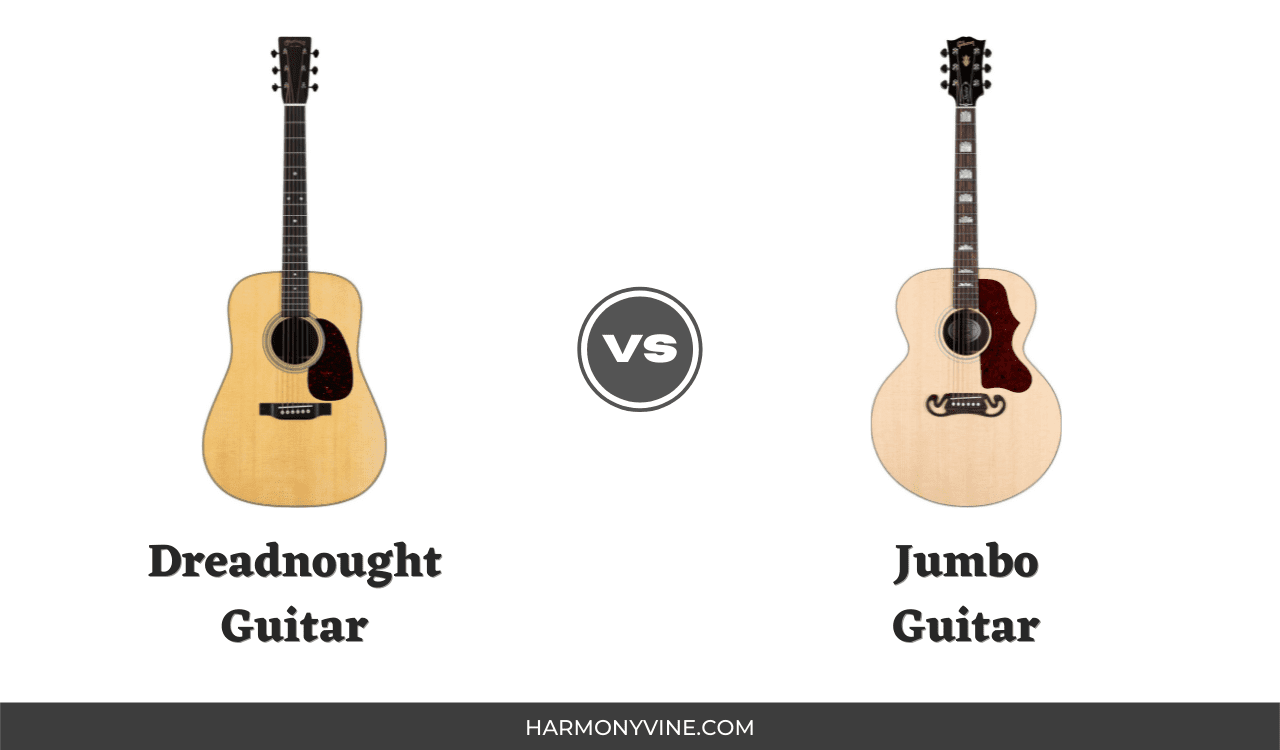Welcome to the battle of the BIG guys!
In this article, I’ll talk about everything you need to know about the Dreadnought vs. Jumbo Guitar debate.
The Dreadnought and Jumbo are two very popular body shapes for acoustic guitars.
Now, if you’re struggling to decide between the two, I’ve prepared this guide that outlines all the differences between these two acoustic guitar shapes.
I’ll also go over their applications so you’ll know exactly which variant suits your needs better.
Keep reading!
What Is a Dreadnought Guitar?
The Dreadnought is the classic acoustic guitar shape originally developed by Martin Guitars in 1916.
Since then, it’s been adapted by other guitar manufacturers and is now the most common shape for acoustic guitars.
It’s probably the first shape that both guitarists and non-guitarists imagine when they think of an acoustic guitar.
There are a few peculiar characteristics of dreadnoughts, some of which are:
- Least pronounced waist of all body shapes
- Highly versatile sound with deep “boomy” bass
- Typical scale length of around 25.5” (647mm)
- Body depth approx. 3.8” – 4.7” (96 – 124mm)
You can literally find hundreds of dread models from pretty much all brands. But the most iconic dreadnoughts are undoubtedly the Martin D-18, Martin D-45, and Gibson Hummingbird.
What Is a Jumbo Guitar?
Jumbo is the big boy of the pack! It’s the largest of all standard acoustic guitar body shapes.
In terms of shape, a Jumbo resembles an oversized cousin of the grand auditorium and is quite a bit different from the dreadnought shape.
It was developed in the 1930s when Gibson decided to launch their own model to capitalize on the success of Martin’s dreadnought. They made it even bigger, with rounder shoulders.
Jumbos commonly have the following characteristics:
- More pronounced waist than the dreadnought, similar to the smaller acoustic shapes
- Even louder sound and with more sustain
- Balanced sound signature
- Typical scale length of around 25.5” (647mm)
- Body depth approx 4.3” – 5.1” (110 – 130mm)
The original jumbo guitar (also given the moniker “Super Jumbo”), the Gibson SJ-200 was immediately well-received due to its ‘big’ sound and deep punchy bass. Other popular jumbo models include the Martin J40 and Takamine GJ72CE, among others.
Dreadnought vs Jumbo Guitars: Differences
Body Shape
Here’s a quick overview of the differences in body dimensions (approximate values) of these two shapes:
| Dreadnought (Martin D-18) | Jumbo (Gibson SJ-100) | |
| Scale Length | 25.5” | 25.5” |
| Body Length | 20” | 20.5” |
| Body Depth | 4.8” | 4.8” |
| Lower Bout Width | 15.6” | 17” |
| Upper Bout Width | 11.5” | 12.25” |
| Waist | 10.75” | 10.25” |
We may conclude from the table above that:
- Jumbo has an overall wider body but a narrower waist. This gives it a rounder, more pleasing shape (at least to some players’ eyes).
- Dreadnought having that wider waist, has a ‘boxy’ shape to it.
- The curved shape of Jumbos makes them more comfortable for their big size.
Sound
It might seem like there can’t be a big difference in the sound of these two, and there’s some truth to it.
Jumbo Acoustic Guitars: Jumbos are shaped like Grand Auditorium guitars, just bigger. As a result, a good jumbo guitar will have the perfect balance of bass, mids, and treble. Needless to say, a larger size means both more volume and more energy required to get a good sound.
Dreadnought Acoustic Guitars: On the other hand, a dreadnought has enhanced bass but still very responsive mids and treble. A peculiar feature of dreadnoughts is a slightly scooped midrange due to the wider waist. This is ideal for vocalists as their voice can sit in front of the mix.
Interestingly enough, the choice of materials can have a significant impact on sound too.
Jumbos are mostly made with maple back and sides (yes, there are other options too, but this is most common). Maple is one of the most bright and crisp kinds of wood.
But due to the very large body, Jumbos might not be very responsive when played lightly or with fingers. This leads to a guitar that’s surprisingly quiet until you really attack it.
Dreadnoughts come in all sorts of woods, ranging from Spruce, Mahogany, Rosewood, Maple, and some others. This adds incredible versatility to these, as you’ll likely find a dread that sounds perfect for your taste and genre.
Versatility
I’ll have to say this: both dreadnought and jumbo are highly versatile acoustic body shapes. But the dreadnought is simply the better option if you’re looking for versatility.
Where Jumbos might not feel comfortable to smaller players, Dreadnoughts work well for most players unless you’re a kid or really small.
The sound and responsiveness also affect the versatility of these guitars.
- Jumbo guitars don’t respond well to gentle playing or articulate fingerpicking. So these are really suited for heavy strumming or in a band where you need a lot of power and projection yet maintain some top-end clarity.
- Dreadnought guitars are suited for pretty much everyone and every scenario. Excellent for strumming, fingerpicking, performing solo, or even practicing at your home.
FAQs
u003cstrongu003eAre Jumbo Guitars Louder Than Dreadnoughts?u003c/strongu003e
Jumbo guitars being larger in size than typical Dreadnoughts, have more ‘air’ inside them. This means more room for vibration and consequently more volume out of them.u003cbru003eu003cbru003eSo, yes, Jumbos are typically louder than Dreadnought guitars. However, the overall loudness also depends on the build, strings, tonewood, and also your playing style.u003cbru003eu003cbru003eIf you want to get the most sound out of a Jumbo, try to find one that’s not too heavily braced. If it’s too heavily built or braced, you’ll need to really put some muscle into it, which isn’t ideal.
u003cstrongu003eWhat Is a Mini Jumbo Guitar?u003c/strongu003e
As the name suggests, a Mini Jumbo is a scaled-down version of a full-sized Jumbo guitar. It has similar proportions to a Jumbo but with a narrower upper/lower bout and less depth.u003cbru003eu003cbru003eMini Jumbos are great options if you’re after the feel and sound of a big guitar, without losing on the comfort of smaller guitars.u003cbru003eu003cbru003eA well-built Mini Jumbo will still have a balanced tone with plenty of bass. However, it won’t be as ‘boomy’ as a dreadnought.
u003cstrongu003eJumbo Guitar vs Dreadnought: Which Is Better For Fingerstyle?u003c/strongu003e
Dreadnought guitars are better for fingerstyle playing as you require less energy to get a good sound out of them.u003cbru003eu003cbru003eDreads also have a very balanced tonal response, so they’ll pick up those treble notes and melodies with ease.u003cbru003eu003cbru003eOn the other hand, getting a good tone out of a Jumbo guitar requires more energy. So you’ll get tired relatively quickly fingerpicking on them.

I’m Pranshu. I’ve been a passionate guitarist, keyboardist, and music producer ever since I got my hands on a keyboard as a small child.
With Harmonyvine, my goal is to share tips and knowledge about music and gear with you. I also enjoy recording music and guitar covers, which you can check out on my Instagram page.


Very good advice
Hi Norman! Glad the info was helpful 🙂
This was really helpful to me too!!!
Thanks for commenting Daniel. I’m glad the post helped you!